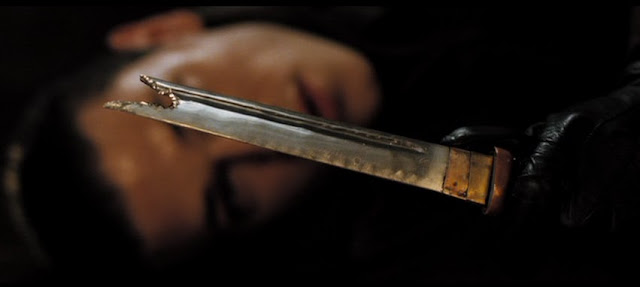Antique Japanese (samurai) katana, Metropolitan Museum of Art. [Image from the Wikipedia 'Katana' page; Antique japanese katana by Emmanuel H., licensed under CC BY 2.0 via Wikimedia Commons.]
There is a graphic scene in the movie in which Hannibal uses a katana sword to cut off a man's (i.e., the butcher's) head. In this post we will explore sword symbolism, but first, a description of the kantana is in order.
Historically, katana were one of the traditionally made Japanese swords that were used by the samurai of feudal Japan. Modern versions of the katana are sometimes made using non-traditional materials and methods. The katana is characterized by its distinctive appearance: a curved, slender, single-edged blade with a circular or squared guard and long grip to accommodate two hands.[a]

Above left: Hannibal holding the katana that he has just used to kill the butcher. Above right: Late in the movie, Hannibal carries a tanto, which has here been damaged by a bullet fired at him by Grutas.
The sword is considered to be a phallic symbol. In this respect, we can connect the 'evolution' throughout the movie of the 'physique' of Hannibal's sword, symbolizing his penis, with Jews who have deformed genitals due to suffering from congenital adrenal hyperplasia (CAH), a medical condition which also causes these Jews to be evil. Early in the movie, Hannibal uses a katana, which is curved. This symbolizes the curved penises of these Jews, some of whom suffer from chordee, a medical condition in which a man's penis is curved upward or downward at the junction of the head with the shaft of the penis.
By the end of our movie, Hannibal has been 'reduced' to using a tanto, a kind of short sword. This symbolizes the reduction in masculinity of the aforementioned evil Jews, reflecting their evil hermaphroditic qualities, which is not only a mix of feminine and masculine physical aspects, but a combined male/female evil as well.
Hannibal's tanto has been concealed by him underneath the jacket he is wearing, between his back and the jacket, when he boards Grutas's houseboat near the end of the movie. When Grutas fires a gunshot at Hannibal's back, Hannibal is protected by the tanto from being wounded or killed by the bullet. Hannibal's tanto itself represents the same sword he started out with (the katana he used to sever the butcher's head), but in a reduced form, as already noted. The final insult to Hannibal's metaphorical phallus is that the bullet which struck the tanto caused damage to it which is irregular and asymmetrical in form (as shown in the above right screencap). This symbolizes an irregular, asymmetrically placed urethral opening, indicating still further the deformed genitals of the evil hermaphroditic Jews (these are the specific evil Jews that Hannibal Lecter represents).
a. Wikipedia, 'Katana'. Web, n.d. URL = https://en.wikipedia.org/wiki/Katana.

